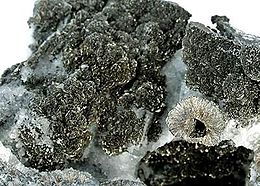
Hornblende is a complex inosilicate series of minerals. It is not a recognized mineral in its own right, but the name is used as a general or field term, to refer to a dark amphibole. Hornblende minerals are common in igneous and metamorphic rocks.
Zirkelite is an oxide mineral with the chemical formula (Ca,Th,Ce)Zr(Ti,Nb)2O7. It occurs as well-formed fine sized isometric crystals. It is a black, brown or yellow mineral with a hardness of 5.5 and a specific gravity of 4.7.

Ullmannite or Nickel glance is a nickel antimony sulfide mineral with formula: NiSbS. Considerable substitution occurs with cobalt and iron in the nickel site along with bismuth and arsenic in the antimony site. A solid solution series exists with the high cobalt willyamite.

Erythrite or red cobalt is a secondary hydrated cobalt arsenate mineral with the formula Co
3(AsO
4)
2•8H
2O. Erythrite and annabergite, chemical formula Ni
3(AsO
4)
2•8H
2O, or nickel arsenate form a complete series with the general formula (Co,Ni)
3(AsO
4)
2•8H
2O.

Mimetite is a lead arsenate chloride mineral (Pb5(AsO4)3Cl) which forms as a secondary mineral in lead deposits, usually by the oxidation of galena and arsenopyrite. The name derives from the Greek Μιμητής mimetes, meaning "imitator" and refers to mimetite's resemblance to the mineral pyromorphite. This resemblance is not coincidental, as mimetite forms a mineral series with pyromorphite (Pb5(PO4)3Cl) and with vanadinite (Pb5(VO4)3Cl). Notable occurrences are Mapimi, Durango, Mexico and Tsumeb, Namibia.
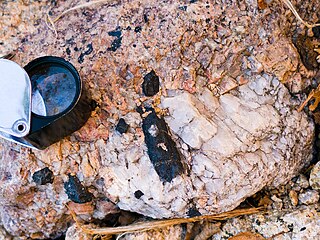
Riebeckite is a sodium-rich member of the amphibole group of silicate minerals, chemical formula Na2(Fe2+3Fe3+2)Si8O22(OH)2. It forms a solid solution series with magnesioriebeckite. It crystallizes in the monoclinic system, usually as long prismatic crystals showing a diamond-shaped cross section, but also in fibrous, bladed, acicular, columnar, and radiating forms. Its Mohs hardness is 5.0–6.0, and its specific gravity is 3.0–3.4. Cleavage is perfect, two directions in the shape of a diamond; fracture is uneven, splintery. It is often translucent to nearly opaque.

Pyrargyrite is a sulfosalt mineral consisting of silver sulfantimonite, Ag3SbS3. Known also as dark red silver ore, ruby blende, garnete blende or ruby silver, it is an important source of the metal.

Cohenite is a naturally occurring iron carbide mineral with the chemical structure (Fe, Ni, Co)3C. This forms a hard, shiny, silver mineral which was named by E. Weinschenk in 1889 after the German mineralogist Emil Cohen, who first described and analysed material from the Magura meteorite found near Slanica, Žilina Region, Slovakia. Cohenite is found in rod-like crystals in iron meteorites.

Stephanite is a silver antimony sulfosalt mineral with formula: Ag5SbS4. It is composed of 68.8% silver, and sometimes is of importance as an ore of this metal.

Hausmannite is a complex oxide, or a mixed oxide, of manganese containing both di- and tri-valent manganese. Its chemical formula can be represented as MnIIMnIII2O4, or more simply noted as MnO·Mn2O3, or Mn3O4, as commonly done for magnetite, the corresponding iron oxide. It belongs to the spinel group and forms tetragonal crystals. Hausmannite is a brown to black metallic mineral with Mohs hardness of 5.5 and a specific gravity of 4.8.

Loellingite, also spelled löllingite, is an iron arsenide mineral with formula FeAs2. It is often found associated with arsenopyrite (FeAsS) from which it is hard to distinguish. Cobalt, nickel and sulfur substitute in the structure. The orthorhombic lollingite group includes the nickel iron arsenide rammelsbergite and the cobalt iron arsenide safflorite. Leucopyrite is an old synonym for loellingite.
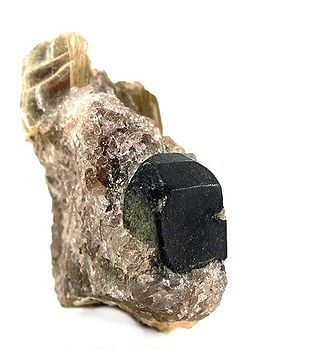
Triphylite is a lithium iron(II) phosphate mineral with the chemical formula LiFePO4. It is a member of the triphylite group and forms a complete solid solution series with the lithium manganese(II) phosphate, lithiophilite. Triphylite crystallizes in the orthorhombic crystal system. It rarely forms prismatic crystals and is more frequently found in hypidiomorphic rock. It is bluish- to greenish-gray in color, but upon alteration becomes brown to black.
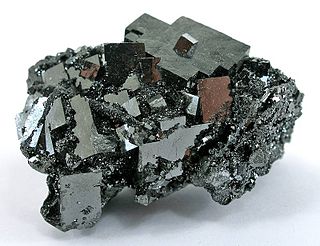
Bixbyite is a manganese iron oxide mineral with chemical formula: (Mn,Fe)2O3. The iron/manganese ratio is quite variable and many specimens have almost no iron. It is a metallic dark black with a Mohs hardness of 6.0 – 6.5. It is a somewhat rare mineral sought after by collectors as it typically forms euhedral isometric crystals exhibiting various cubes, octahedra, and dodecahedra.
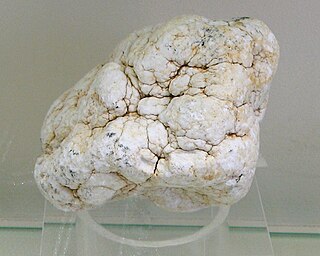
Aluminite is a hydrous aluminium sulfate mineral with formula: Al2SO4(OH)4·7H2O. It is an earthy white to gray-white monoclinic mineral which almost never exhibits crystal form. It forms botryoidal to mammillary clay-like masses. It has a very soft Mohs hardness of 1–2 and a specific gravity of 1.66–1.82.

Allophane is an amorphous to poorly crystalline hydrous aluminium silicate clay mineraloid. Its chemical formula is Al2O3·(SiO2)1.3-2·(2.5-3)H2O. Since it has short-range atomic order, it is a mineraloid, rather than a mineral, and can be identified by its distinctive infrared spectrum and its X-ray diffraction pattern. It was first described in 1816 in Gräfenthal, Thuringia, Germany. Allophane is a weathering or hydrothermal alteration product of volcanic glass and feldspars and sometimes has a composition similar to kaolinite but generally has a molar ratio of Al:Si = 2. It typically forms under mildly acidic to neutral pH (5–7). Its structure has been debated, but it is similar to clay minerals and is composed of curved alumina octahedral and silica tetrahedral layers. Transmission electron micrographs show that it is generally made up of aggregates of hollow spherules ~3–5 nm in diameter. Allophane can alter to form halloysite under resilicating aqueous conditions and can alter to form gibbsite under desilicating conditions. A copper-containing variety cupro-allophane has been reported.
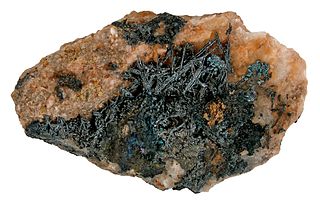
Stromeyerite or copper-silver glance is a sulfide mineral of copper and silver, with the chemical formula AgCuS. It forms opaque blue grey to dark blue orthorhombic crystals.

Zincobotryogen is a hydrous sulfate mineral with the chemical formula (Zn,Mg,Mn)Fe3+(SO4)2(OH)·7H2O. It forms bright orange red monoclinic prismatic crystals that exhibit a vitreous to greasy luster. Its specific gravity is 2.201 and it has a Mohs hardness of 2.5.

Alabandite or alabandine, formerly known as manganese blende or bluemenbachite is a rarely occurring manganese sulfide mineral. It crystallizes in the cubic crystal system with the chemical composition Mn2+S and develops commonly massive to granular aggregates, but rarely also cubic or octahedral crystals to 1 cm.

The silver antimonide mineral dyscrasite has the chemical formula Ag3Sb. It is an opaque, silver white, metallic mineral which crystallizes in the orthorhombic crystal system. It forms pyramidal crystals up to 5 cm (2.0 in) and can also form cylindrical and prismatic crystals.
